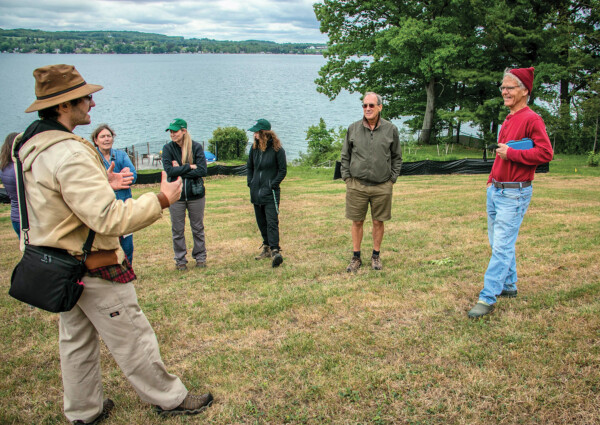
Sam Quinn ’07 of ESF explains next steps to landowners Dan Fisher and Birney Imes as part of the RSC’s Lawn to Meadow restoration program. The site is being cleared of existing turf grass and prepared for seeding of the new meadow. Also pictured are Brandy Neveldine ’09, Jess Proctor, Beth Imes and Lori Ruhlman.
Dan Fisher and Lori Ruhlman purchased their house on East Lake Road in Skaneateles in 2017, just three months before the first documented harmful algal bloom on Skaneateles Lake. They started learning all they could about ways that homeowners might help preserve/save the lake. Here’s what they told ESF Magazine about their work with the RSC’s Lawn to Meadow program.
With the guidance of several local sources and organizations, we planted 100-plus native shrubs and flowers on the northern border and along the lake bank. But we wanted to do more. It was the people at ESF who helped show us how to dig in and make the biggest impact after the algal bloom. The Colony, where we live on Skaneateles Lake, is unique with its beautiful wide-open lawns that sweep down to the lake. Although they provide wonderful views, we learned that these mowed lawns offer no filter for the lake. Our neighbors, Birney and Beth Imes, shared our concerns and connected us to Don Leopold at ESF, who introduced us to Sam Quinn.
With Sam’s help, an acre of our two properties — between the houses and the lake— will be turned into a flowering meadow. This will create an upside-down forest of roots in the earth and help protect the lake. In addition, the native flowers will provide a home for bees, butterflies and songbirds.
We are not big gardeners, and we never would have attempted this without the partnership with the Restoration Science Center and Sam’s guidance, wisdom and enthusiasm. Having the support and knowledge of the team at the Restoration Science Center has not only made this project possible – it has made the planning fun, educational and exciting.
We are excited to return these spaces to what they were over 100 years ago, before widespread mowing was in vogue – back when the yards were meadows with paths connecting neighbors to each other and to the lake. We are stewards of this beautiful piece of the Earth for a short time. It is rewarding to think we can make some changes that will benefit the lake and the environment long after we are here.


